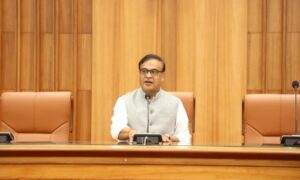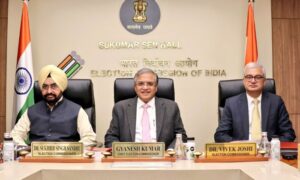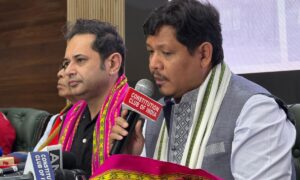
File Picture
It is somewhat unnerving to note that in the public discourse on budget these days the issue of balanced regional development is hardly raised. This is somewhat unfortunate because till the 12th Five year plan this was an important component of development planning;and therefore policies and projects designed to remove or reduce regional imbalances were debated,scrutinized and results evaluated. Presently the entire focus of the budget debate is on the macro economic issues and not on regional development issues of even border states.
The fact that the north east regional media noted that in the budget speech of the Union Finance Minister no mention was made to the special development challenges of the north east even when substantial increase in the allocations for the North East were proposed suggests the need to restore regional imbalances in development as central to ‘ inclusive growth’ strategy by putting in place growth enabling policies, infrastructure and institutions in the region under a coordinated program of the center and North East states.
Now let’s look at the budget figures; first,it hiked allocations for the North East by Rs 12282cr across 55 central ministries of Rs 59369.30cr as compared to Rs 47087.95cr of last financial year, that is, a substantial 21% increase. Looking into details it is seen that while the allocations for road transport have been reduced to Rs 6070 cr as against last year’s provision of Rs6210cr, that of water resources raised to Rs 440.65cr from Rs 318.82cr.
This is a welcome step as flooding of Brahmaputra has been causing right now huge damages in Assam and Garo hills in Meghalaya where the flood control structures need repairs and redesigning in many areas. The region’s unmet need for an integrated approach to the river basin management and especially sustainable flood moderation of Brahmaputra that the 2007 Strategy Report of the World Bank on Development and Growth of North East India stressed calls for urgent steps as there are definite signs of climate change and growing environmental insecurity.
While the provisions for DONER is up from 2018-19 Revised estimate of Rs 2629cr which is roughly the actual expenditure to Rs 3000cr, the decrease in the NEC budget from Rs 1010 cr to Rs 885.15cr is an indication of NEC’s declining role in region’s development. This is somewhat disquieting as under the NEC Act, the council is mandated to to ” prepare a regional plan”for development of the north east and to execute projects of regional importance meaning projects which will benefit more than one state.
As the NEC is based in Shillong and specialised agencies like the NEEPCO it promoted are in the know of the ground conditions more than DONER it is better equipped to appreciate the development needs and also to implement projects with full involvement of the north east states. DONER on the other hand has been engaged mainly since its inception in managing Non Lapsable 10% of central funds that the central ministries and other agencies are required to spend in the north east which has made DONER primarily a coordinating body.
Equally disquieting though not unexpected is the token allocation for the Hindustan paper corporation run two paper Mills in Assam which are all set for liquidation and with this comes the end of Assam’s dream of large industries using jute and bamboo as locating such plants far away from the ports and market involving high transport cost rendered them unviable. This should be factored in planning Act East interaction of north east with the Asean and not just Myanmar because high surface transport cost of accessing the main Asean markets for most Industrial products might render these products uncompetitive.
However when one looks at the physical progress of centrally funded infrastructural development schemes in the north east the position has vastly improved since 2014; as for example the completion of Belonia- Sabroom section of the NFRailway in Tripura will enable it to run trains between the entire 114.6km Agartala- Sabroom stretch constructed over 10 years and at the cost of Rs 3323.07cr. The works on Dimapur- Kohima Rail Link, Kaladan Multi Modal transport project to link Sittwee Sea Port of Myanmar with Mizoram and the North East and such other connectivity, power and Telecom projects have been accorded high priority; and once completed these will remove” transport bottleneck” for movement of goods and services considered for long as the main constraints on development of the region.
Development experience in a number of third world countries suggests that infrastructural development by itself doesn’t generate growth as for example Nigeria where huge investment in physical infrastructure- much of it was unnecessary and mainly benefitted the foreign contractors and suppliers and their cronies in the government. It didn’t create a self sustaining growth base though imposed a huge maintenance cost on the state. Hence its viability is established only when it generates sustainable growth and employment. In the Indian context growth has been mainly urban- technology driven which has been eluding north east so far.
Take the case of Assam with its 4.4 million urban population out of the total population of 3.11 cr has only one million plus Guwahati urban agglomeration and 28 municipalities is the 12th least urbanised state and therefore a low potential for employment in service sector which explains the reason for huge migration of its youth- skilled and unskilled to southern states and its low rank in NSDP percapita among the states and UTs. The position is equally dismal in the region as there are only 13 Municipal towns in the rest of the NE.
This amazing transformation of a tribal and shifting cultivation ( jhum) based economy in less than half a century is one of unexpected outcomes of the decision taken in the wake of outbreak of the Mizo insurgency in 1966 to ” group ” the far flung villages and relocate them close to the Road network to provide security and comprehensive development support which would not have been possible but for this initiative.
These ” grouped” villages designated as PPVs- Protected and Progressive Villages were organised during 1966 -1968 under the dynamic leadership of R. Natarajan, Deputy Commissioner Mizo District which covered the whole of today’s Mizoram developed into permanent vibrant urban centres providing marketplaces and facilities for acquiring modern skills and activities under secondary and services sectors.
Some of these PPVs like the one at Serchip is now a District HQ. Not unsurprisingly Mizoram holds 19 th position among 33 states/UTs with a percapita NSDP of Rs 129057 and is among the most urbanised states with 52.1% of its present population of about 1.3 million is urban and US$7110. It is placed second in the region after Arunachal Pradesh ( Percapita NSDP Rs 135163 ). Third rank in literacy- 91.3% and high position in Human development index. Aizawl, Mizoram’ capital with a population of about 1.5 lakh has the highest density of vehicles in the country. The tiny Mizoram is also a sports powerhouse.
What lessons would Mizo development experience – we might even call it the Mizo model- hold for other NE States? It is the” forced urbanization” that triggered the modernization of the Mizo society and economy and not just growth of infrastructure. Thus planned urbanization geared to promote medium Small and Micro enterprises and linked to skill and entrepreneurship development backed up by the institutional finance is the only way to generate employment within the region and a step towards inclusive growth.
From this perspective building an Economic and urban Corridor linking Gangtok- Siliguri- Bongaigaon- Guwahati- Shillong- Silchar,- Aizawl merits consideration by the Region’s planners; because without planned urbanization costly investments in infrastructure such as the ongoing project to extend the Railway Link to Kohima from Dimapur-may turn out to be what Andre Gunder Frank called” the development of underdevelopment”.


















